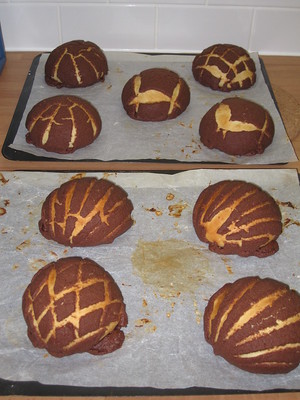Again, a last minute dinner decision on the omelet, but I decided to try and make it a bit more special, by frying sliced onion in some butter and also slicing and frying some shiitake mushrooms also in butter. I kept them separate, as they'd take different times to cook.
I whisked a couple of eggs together with a splash of milk, salt and pepper, then fried it in a little butter as well. When it was almost ready, I added some onions and mushrooms to one half, then managed to fold the omelet with the help of a couple of spatulas. I don't feel as confident as professional chefs to just flick it into folding. it was difficult to get onto the plate in a good way too, only one of the omelets worked. I decorated with a couple of slices of "Fillet Elena" (филе Елена), which is a Bulgarian cured and dried fillet meat - similar idea to billtong, but not as hard. Together with the tomatoes I bought from our new greengrocer's, it turned into a very yummy mid-week meal.
I've also had success with the latest batch of bread.
Having almost run out of flour (unheard of!), I took out 150 g of my starter "Monty", added to that 100 g strong white flour and 100 g wholemeal flour along with 100 g water, which turned into a fairly stiff starter. I closed the jar tightly and went off to the shops (to buy more flour among other things).
Back some 5 h later and there was pssst-ing and sigh-ing in the kitchen. Turns out, Monty was so happy about the feed, he'd fed intensely and generated such a pressure in the jar that the lid had bent and the starter had run over and was working its way on the work surface. So no time to lose.
I put the starter in the mixer bowl - it was 380 g in total. To this I added 150 g wholemeal flour (all I had left) and 800 g strong white flour. Then topped up with 410 g water. After almost full gluten development (i. e. 8 min kneading in the machine) I added 15 g salt and 0.5 dl olive oil. I let the machine run for another 6 minutes and still most of the olive oil had not been incorporated, so I stopped it before it burnt out the engine and started kneading by hand. This worked a lot better and all the oil went in fine. This is the first time I've added fat to a sourdough, very exciting.
The dough went into the bowl again for a rest of 1 h 30 min, while I took the opportunity to make a tepee over my tubs of potatoes, to protect them from filling up with water from all the rain we've been having.
The dough rose very nicely in the mean time. It weighed just over 1600 g, so I divided it into three and shaped into loaves that went into my three loaf tins. The dough was quite stiff this time, at about 50% hydration, so very easy to work with. I gently pushed each part out onto the surface into a rectangle, then rolled it into a loaf.
Once in the tins, I brushed with more olive oil and sprinkled a mixture of polenta, crushed oat bran, sesame and black onion seeds. Then covered with cling film and left to rise for about 4 h. I could have left it a bit longer, but it was nearing bed time and I didn't want to leave them overnight or the dough would try to escape again.
I baked the loaves for 20 minutes on 250 degrees C, then turned down to 200 degrees C and gave them another 30 minutes.
Lundulph and I had some for lunch today and both texture and flavour was super. I must remember not to use as much water as I have up to now. My previous breads have worked out to some 90 - 100 % hydration, which has resulted in a sloppy dough and not too pretty loaves (though they were quite tasty too). I also resisted the temptation to slash the loaves, though I suspect I would have been more successful than before. Drooling over the photos in The Fresh Loaf, I've noticed that some breads had poor excuses for slashes, just like mine and it occurred to me that it might have to do with how wet a dough is.
So now we're set for another couple of weeks of bread and I'll have to try and make pancakes with the surplus of sourdough I'll end up with when I feed Monty next week.
By the way, Lundulph didn't like my tepee and I had to take it down today and made a more discreet looking poly tunnel. It rained really heavily in the afternoon with a fair bit of wind too, but the thing is still standing, so all is well in the garden, looking forward to some lovely tatties.






